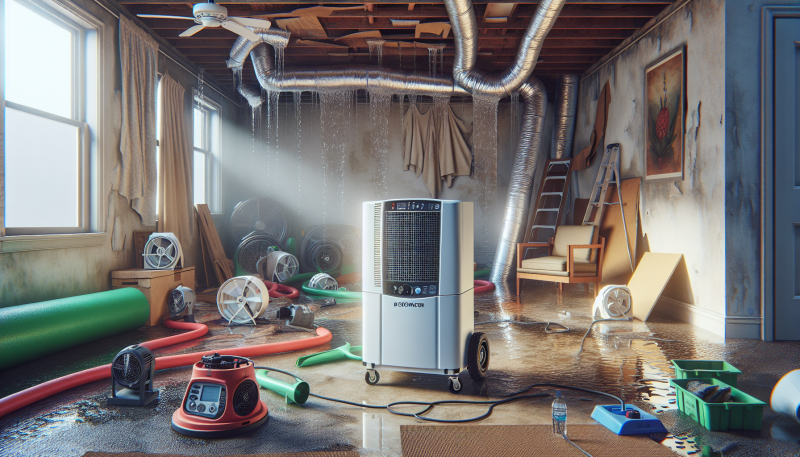When disaster strikes, whether it’s water damage, fire, or mold, the restoration process can feel overwhelming. One crucial aspect that often gets overlooked is dehumidification. This article will explore the vital role of dehumidification in effective restoration, particularly in commercial property restoration and residential property restoration. We’ll dive into how it aids in water damage restoration, mold assessment and remediation, and more. So, let’s get started!
Understanding Dehumidification
Dehumidification is the process of removing excess moisture from the air. Why is this important? Well, moisture can lead to a host of problems, including mold growth, structural damage, and even health issues. In the context of dehumidification, it’s essential to understand that it’s not just about drying out a space; it’s about creating a safe and healthy environment.
When dealing with water damage, for instance, the first step is often to remove standing water. But what happens next? If the air remains humid, it can hinder the drying process and lead to mold growth. This is where dehumidifiers come into play. They help maintain optimal humidity levels, ensuring that the restoration process is effective and efficient.
The Importance of Dehumidification in Water Damage Restoration
Water damage restoration is a multi-step process that requires careful planning and execution. After the initial cleanup, dehumidification is crucial. It not only speeds up the drying process but also prevents secondary damage. Imagine trying to dry a wet sponge without squeezing it first; it just won’t work! Similarly, without proper dehumidification, moisture can linger and cause further issues.
In commercial property restoration, the stakes are even higher. Businesses can’t afford prolonged downtime. By utilizing 24/7 emergency services for dehumidification, businesses can get back on their feet faster. This is particularly important for industries that rely on strict hygiene standards, such as food services and healthcare.
Mold Assessment and Remediation: A Critical Connection
One of the most significant risks associated with water damage is mold growth. Mold can start to develop within 24 to 48 hours of water exposure. This is where mold assessment and remediation come into play. Dehumidification is a key player in this process. By keeping humidity levels low, the chances of mold spores settling and growing are drastically reduced.
When you call in experts like Projekt Restoration, they not only assess the damage but also implement dehumidification strategies to prevent mold from becoming a bigger issue. This proactive approach is essential for maintaining a safe environment, especially in residential settings where families live and breathe.
Fire Damage Restoration: The Overlooked Aspect
Many people associate dehumidification primarily with water damage, but it’s also crucial in fire damage restoration. After a fire, the water used to extinguish the flames can lead to significant moisture problems. If not addressed, this moisture can lead to mold growth and structural damage.
In fire damage scenarios, dehumidifiers help to remove excess moisture from the air and materials. This not only aids in the drying process but also helps eliminate odors that can linger after a fire. By incorporating dehumidification into the restoration plan, you ensure a more thorough and effective recovery.
Biohazard Cleanup and Dehumidification
Another area where dehumidification plays a vital role is in biohazard cleanup. Whether it’s due to flooding, sewage backup, or other hazardous situations, controlling moisture is critical. High humidity can exacerbate the spread of contaminants and create an unhealthy environment.
By utilizing dehumidification techniques, restoration experts can create a safer space for cleanup and recovery. This is especially important for insurance claims assistance, as thorough documentation of the cleanup process can help ensure that claims are processed smoothly.
Conclusion
In summary, dehumidification is a crucial component of effective restoration, whether it’s for water damage, fire damage, or mold remediation. By maintaining optimal humidity levels, you can prevent further damage and ensure a safe environment. If you’re facing restoration challenges, remember that Projekt Restoration is your go-to water, fire, & mold restoration experts. We also offer biohazard cleanup and reconstruction services. Don’t hesitate to reach out for low pricing and 24/7 emergency services!
FAQs
What is dehumidification?
Dehumidification is the process of removing excess moisture from the air to prevent mold growth and structural damage.
How does dehumidification help in water damage restoration?
It speeds up the drying process and prevents secondary damage, such as mold growth.
Can dehumidification prevent mold?
Yes, by maintaining optimal humidity levels, dehumidification significantly reduces the chances of mold growth.
Is dehumidification necessary after fire damage?
Absolutely! It helps remove moisture from firefighting efforts and prevents mold growth.
How can I get assistance with restoration services?
You can contact Projekt Restoration for expert help with water, fire, and mold restoration.





